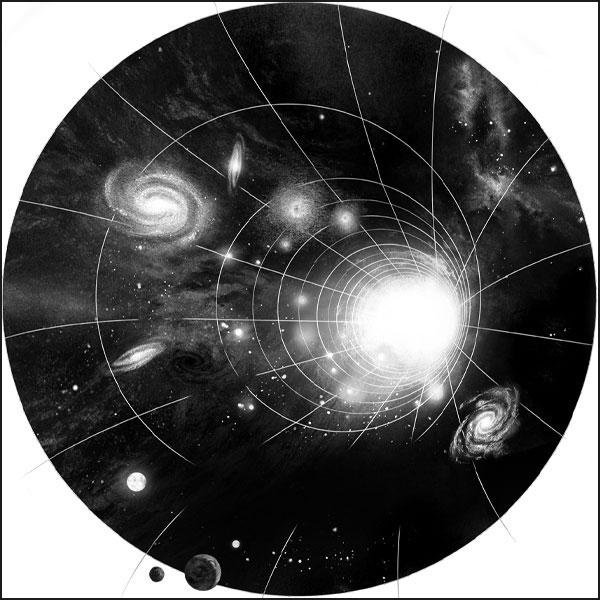Debate
Are chorizo-style scientific hoaxes dangerous?
A French scientist caused a furore when he posted a photo of a slice of chorizo sausage online, pretending that it was an image of an alien world sent back to Earth by the James Webb Telescope. Is there any risk with jokes like that?

Image: Vera Hartmann / 13PHOTO

Image: Salvatore Di Nolfi / Keystone
The French scientist Étienne Klein tweeted a photo of a slice of chorizo, passing it off as an image made by the James Webb Space Telescope: “This level of detail … A new world is revealed every day”. Three days later, he apologised to all those gullible souls whom he might have offended with his joke, saying that he had “simply wanted to encourage caution with regard to images that seem eloquent by themselves”.
A joke can be all the more successful when its lack of complication goes hand in hand with great comic effect. Klein’s social media prank was in this sense highly successful. For one thing, there are light years of difference between a photograph of a slice of Spanish sausage and an image made with a space telescope that cost USD 10 billion. In fact, the difference is literally 3.14 million light years. This alone makes the parody so delightfully funny. This joke, moreover, is an epistemological heavyweight that has been reduced to the minimum. How many times do we have to read how functional magnetic resonance imaging (fMRI) can enable us to “watch the brain think”? Regrettably, no one seems to find the unintentional comedy of this claim funny at all. What ‘we’ can actually do instead (the abstract collective pronoun alone should make us sceptical) is this: with the help of fMRI, we transform the oxygen saturation in different regions of the brain into sequences of coloured diagrams, with a delay as a deviation from a standard model that has been calculated by scanning many different brains.
It’s part and parcel of any general education in the philosophy of science that a discovery cannot be detached from the context in which it was made. Likewise, an image is bound to the context of its production and its medium. Therefore, this hoax was not just funny, but clever too, because it heightened our awareness of how facts are created in the sciences – in terms of their technology, their media and their experimental origins. They don’t just fall into your lap by chance like Newton’s apple.
Peter Schneider is a psychoanalyst, columnist and satirist as well as a lecturer in clinical psychology at the University of Zurich. He has published various books on psychoanalysis, psychiatry and the philosophy of science, the last being ‘Follow the Science’ in 2021.
In the US, hungry emergency room interns are waiting for pizza to be delivered when they’re called to treat a gunshot victim. They strive to save the young man’s life, but to no avail. It turns out to be the pizza delivery guy. They soon find their food on the hospital doorstep, perfectly edible. One of them asks, “How much you think we ought to tip him?”. They laugh, and eat the pizza.
Too often our relationship with humour is fraught with misunderstanding. As is illustrated by this joke – taken from an article where it was analysed – medical humour can be very dark and sometimes very crude, offending successive generations of interns. Admitting being shocked or offended isn’t always possible, and we come across as being anti-humour. Does this point to a clash between what we owe each other and the importance of laughter? Some time ago, the lawyer Katie Watson carried out a useful exercise, categorising humour by function. In between the lines of jokes, we communicate a wide range of messages to each other. We joke to tell the truth more quickly, to make what has power over us less threatening, or to restore a semblance of reality where an imbalance would otherwise be unbearable. We laugh at death itself, the ultimate example of punching up. This humour is vital, sometimes literally. But when it comes to the language of laughter, messages that would otherwise be problematic are always problematic, even if they’re funnier. We laugh at those weaker than us, a laughter of rejection and even humiliation. “Where’s your sense of humour?” is not really the appropriate question.
Turning to the example of the chorizo slice, what messages are being communicated? “Beware of images on the Internet”, say physicists. “You’re gullible fools”, say lovers of science and beautiful images, including those who feel betrayed. So let’s be careful about how our messages are received, as it must count for something, with or without humour.
Samia Hurst is a professor in medical bioethics at the University of Geneva and an advisor to the Clinical Ethics Council at the University Hospitals in Geneva (HUG). She is the editor of the journal Bioethica Forum and was a vice-chair of the Swiss National COVID-19 Task Force.

Image: Vera Hartmann / 13PHOTO
The French scientist Étienne Klein tweeted a photo of a slice of chorizo, passing it off as an image made by the James Webb Space Telescope: “This level of detail … A new world is revealed every day”. Three days later, he apologised to all those gullible souls whom he might have offended with his joke, saying that he had “simply wanted to encourage caution with regard to images that seem eloquent by themselves”.
A joke can be all the more successful when its lack of complication goes hand in hand with great comic effect. Klein’s social media prank was in this sense highly successful. For one thing, there are light years of difference between a photograph of a slice of Spanish sausage and an image made with a space telescope that cost USD 10 billion. In fact, the difference is literally 3.14 million light years. This alone makes the parody so delightfully funny. This joke, moreover, is an epistemological heavyweight that has been reduced to the minimum. How many times do we have to read how functional magnetic resonance imaging (fMRI) can enable us to “watch the brain think”? Regrettably, no one seems to find the unintentional comedy of this claim funny at all. What ‘we’ can actually do instead (the abstract collective pronoun alone should make us sceptical) is this: with the help of fMRI, we transform the oxygen saturation in different regions of the brain into sequences of coloured diagrams, with a delay as a deviation from a standard model that has been calculated by scanning many different brains.
It’s part and parcel of any general education in the philosophy of science that a discovery cannot be detached from the context in which it was made. Likewise, an image is bound to the context of its production and its medium. Therefore, this hoax was not just funny, but clever too, because it heightened our awareness of how facts are created in the sciences – in terms of their technology, their media and their experimental origins. They don’t just fall into your lap by chance like Newton’s apple.
Peter Schneider is a psychoanalyst, columnist and satirist as well as a lecturer in clinical psychology at the University of Zurich. He has published various books on psychoanalysis, psychiatry and the philosophy of science, the last being ‘Follow the Science’ in 2021.

Image: Salvatore Di Nolfi / Keystone
In the US, hungry emergency room interns are waiting for pizza to be delivered when they’re called to treat a gunshot victim. They strive to save the young man’s life, but to no avail. It turns out to be the pizza delivery guy. They soon find their food on the hospital doorstep, perfectly edible. One of them asks, “How much you think we ought to tip him?”. They laugh, and eat the pizza.
Too often our relationship with humour is fraught with misunderstanding. As is illustrated by this joke – taken from an article where it was analysed – medical humour can be very dark and sometimes very crude, offending successive generations of interns. Admitting being shocked or offended isn’t always possible, and we come across as being anti-humour. Does this point to a clash between what we owe each other and the importance of laughter? Some time ago, the lawyer Katie Watson carried out a useful exercise, categorising humour by function. In between the lines of jokes, we communicate a wide range of messages to each other. We joke to tell the truth more quickly, to make what has power over us less threatening, or to restore a semblance of reality where an imbalance would otherwise be unbearable. We laugh at death itself, the ultimate example of punching up. This humour is vital, sometimes literally. But when it comes to the language of laughter, messages that would otherwise be problematic are always problematic, even if they’re funnier. We laugh at those weaker than us, a laughter of rejection and even humiliation. “Where’s your sense of humour?” is not really the appropriate question.
Turning to the example of the chorizo slice, what messages are being communicated? “Beware of images on the Internet”, say physicists. “You’re gullible fools”, say lovers of science and beautiful images, including those who feel betrayed. So let’s be careful about how our messages are received, as it must count for something, with or without humour.
Samia Hurst is a professor in medical bioethics at the University of Geneva and an advisor to the Clinical Ethics Council at the University Hospitals in Geneva (HUG). She is the editor of the journal Bioethica Forum and was a vice-chair of the Swiss National COVID-19 Task Force.




